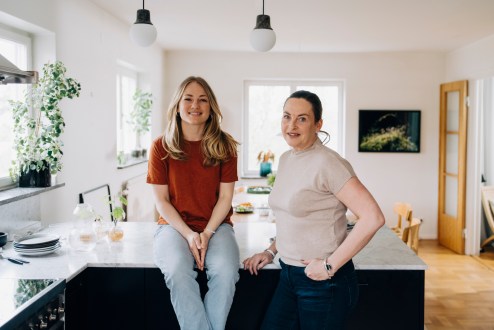How to supercharge your goal-setting
Do you set goals but constantly sabotage yourself? You are not alone, says Anita Chaudhuri. Here, she tries out Psychologies’ Achieve Your Goals online course to discover if she can stop procrastinating and just get on with it

Welcome to the most intensive, productive and daring four weeks you may ever have encountered,’ says coach Magdalena Bak-Maier, introducing the Psychologies Achieve Your Goals online course. I quake inwardly. Am I really up for this?
Ordinarily, I am the first to volunteer for the latest personal development adventures but, over the past few months, have been dogged by health challenges and my energy levels are more damp squib than sparkling skyrocket. I also can’t decide what goals to focus on for the 30 days. Presently, I’m planning a major home renovation, there’s a photography project I’m desperate to start, and I want to speak better Italian before my holiday. No wonder I never finish anything.
Week One: Adding colour
I needn’t have worried, because not long after logging on to the video for Day One, Magdalena addresses my concern. ‘To thrive is to grow in existing conditions,’ she announces. In other words, there’s no point waiting until circumstances are ideal – you have to create the life you want in the here and now. One of the big problems with goal-setting, according to Magdalena, is that we often pour all our energy into one area of focus, at the expense of everything else.
‘Life is a combination of action and rest, and an enjoyment of both,’ she says. ‘Whatever you paint on your canvas will be the experience of life that you get.’
At the heart of the course is The Grid, an ingenious goal-tracking system with a strong visual element. The best way to describe it is a sort of advent calendar for all your goals and projects. Ordinarily the very word ‘system’ makes me need a nap and I have an allergy to diaries and calendars. Did I mention I hate to-do lists?
When Magdalena mentions we’re going to use lots of coloured highlighter pens, my mood brightens. When she says we have to pick one main goal, but can also have two or three smaller ones, I’m even happier. The basic idea is that we mark on The Grid all the ‘to-dos’ in our life to keep things running, then we also display the to-dos involved with working towards our precious dreams and personal goals.
I decide to make health my main goal, then add sub-goals for home revamp, photography and Italian. Magdalena’s aim is to try and achieve balance between home and work, and between activities that use up energy, and those that restore it. Coloured markers at the ready, I fill out my grid with plenty of mini-goals as suggested by Magdalena. Start photography project; Make a plan to feel better; Practise Italian; read three windows on my grid. Excited, I sail off into the next seven days, checking in with Magdalena’s daily lessons as I go.
Week Two: Making it finite and doable
The idea with The Grid is that you colour in the windows with a highlighter pen when you’ve completed a task. But as we approach Week Two, I must face an uncomfortable truth. There’s no hiding place with this system. Yes, I have coloured in all my work to-dos, my life admin, social life and family to-dos. But what about my dreams for the future? I’ve bought a copy of an interiors magazine, downloaded a language app and tried not to eat crisps. Hardly productive. What’s gone wrong?
The key detail I overlooked was that each mini-goal needs to be finite and doable in one session, be that a 10-minute or four-hour one. Practise Italian and Start photography project are too vague. ‘By making tasks smaller, we increase the feeling of being productive,’ says Magdalena, that is, breaking each goal into mini-goals that are complete actions. ‘Doing this means you’ll get through tasks faster and have variety – the mind needs this to refuel, so you avoid feeling overwhelmed by trying to do something that takes longer than expected.’
I give it a go and start again. For health, I mark on seven squares for a daily 30-minute walk, a square for an online shopping delivery of fruit and veg, another designated for visiting a local health shop to ask advice on supplements. For my photography project, which involves shooting an A-Z of London songs, I decide the first task should be creating a master list of locations, a big job but doable on a rainy Sunday. For Italian, my week’s tasks are to do the Duolingo app’s test to find your level, then to do one lesson each morning. I also mark on numerous items to do with my home revamp.
Week Three: Pumping up the inspiration
By the end of Week Two, I’ve made a lot of progress. But Magdalena also advises us to pay attention to which areas are blocked. Oh dear. I have achieved nothing in my home revamp section.
‘Many of us underestimate the time any given task takes by a whopping 60 to 70 per cent,’ says Magdalena. ‘That means six or seven tasks on an average to-do list won’t get done.’ I’ve fallen into this trap. Something’s got to give and it will have to be the home revamp.
One of Magdalena’s exercises is to analyse your energy levels. I remember how much music motivates me. I turn off the gloomy news, and listen to playlists and podcasts instead.
I am delighted to discover that breaking tasks right down is having an impact. I start looking forward to colouring in the little box for my daily walk and my Italian lessons, and this motivates me to stick to the plan.
Week Four: Beating procrastination
By the end, I’m impressed by how productive I’ve been. Committing to small, seemingly insignificant, tasks and keeping track of my progress, has motivated me to get more done. I am now 20 per cent fluent in Italian. I’ve taken photographs at three London locations and going for a walk is now a habit. Best of all, I have more energy. Procrastination is a thing of the past. How? Faced with a visual reminder of the things I want to do in a week, it’s harder to lie to myself and say, ‘I’ll do it later’.
But, perhaps the biggest lesson of all for me, has been to understand that committing to a plan, and sticking to it, is the only way to ensure that creative dreams will ever get off the ground. Now, where did I put those highlighters?
Try Psychologies’ ‘How to Achieve Your Goals’ online course here. Not sure? Sample our course for free here.
‘How to Achieve Your Goals‘ is a revolutionary and transformational 30-day online course to help you reach your goals holistically and realistically, while keeping every area of your life happy, balanced and productive along the way.
Photograph: iStock








